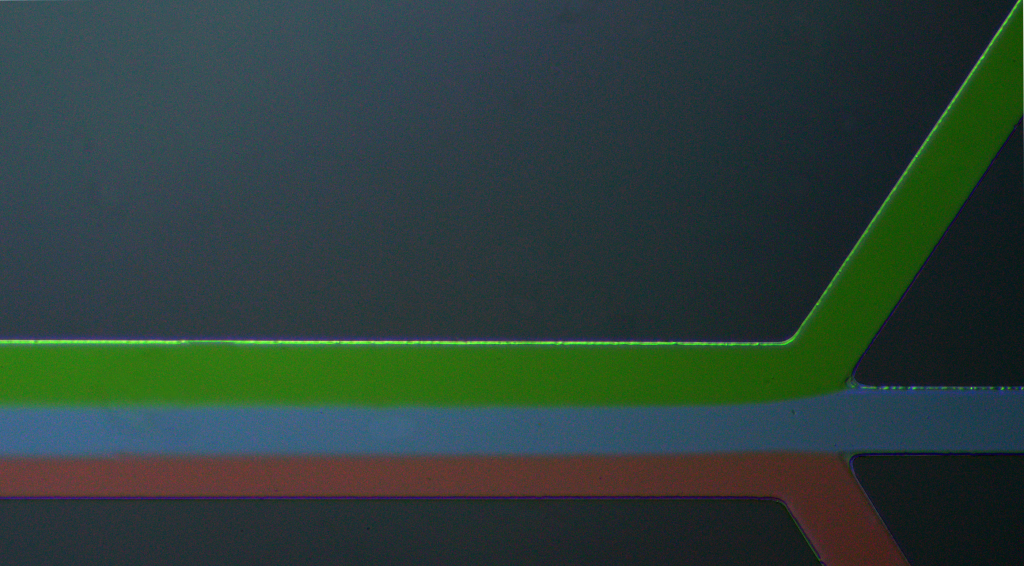This image is of a microfluidic channel made with PDMS. The wide section at left is 400 micron wide, while the feed channels at right are 150 micron wide; all are 23 micron deep. Green, blue, and red dyes dissolved in water are injected into the channels simultaneously. These three streams converge within the wide channel, but because of the nature of fluid flow at these very small dimensions, the expected mixing does not take place. This picture was taken through a fluorescence microscope with top illumination. The image was captured from the bottom through the microscope’s optics for an external camera.
Credit to Hyejin Kwon for constructing the microfluidic channel in PDMS. Kailey Shara and Hyejin Kwon set up the experiment together. The picture was taken and edited by Kailey Shara.
SETUP: At left is the microfluidic device (PDMS on a glass slide), with three pipette-tip reservoirs filled with the dyes. At right one can see some of the green dye running through its channel.
… and here is the final setup on the microscope, with three flexible hoses to deliver air to each channel.

24 Comments. Leave new
Great photo! I enjoy the straightness, geometry, and simplicity of this photo
Great job! You did very well with your experiment and the image is very professional. Could be a Powerpoint stock image.
I like the balance of the image with the stripes. It is very clean with the sharp edges.
Incredible use of science to see the split in different colored inks. The contrast in colors is amazing!
I like this a lot. The fact that you were able to capture this behavior so clearly through this image is awesome.
Im impressed with the evident effort put forth!
Very cool phenomenon going on here
I like the scaling of the image, and how it seems like the three lanes are much bigger when in fact they are microscopic.
It’s fascinating how much different the fluid behavior is on this scale, do you have any idea of the Reynolds numbers for the fluids?
What are you looking for in your research? I really like the image.
This is a pretty cool photo to look at. It’s nice to see images of something that is actually going to be used for research.
I love it. I really like how this looks like the logo of a company. The phenomenon you’re presenting is quite beautiful.
I find it quite fascinating how fluids act differently when they are at this scale. The complexity of this setup is quite impressive!
I think this is an incredible experiment and incredibly unique picture. I also like that you included pictures of the setup.
Great image showing the properties of those fluids and how they behave over small dimensions. Excellent setup as well!
This a gorgeous photo I love how this flow looks similar to a geometric modern art piece. I would love to see more imagery like this with different shapes.
Reminds me of a power point background. Great color choice and such an interesting phenomenon.
This is very very cool. I don’t completely understand what is going on here but I thoroughly enjoy it.
I’m blown away by your experimental set-up here. This picture is very satisfying and very interesting that the dyes do not mix because of the incredibly small scale. I love the simplicity yet intrinsic complexity pictured here.
So impressive you were able to capture this at a microscopic level. Microfluidics is an amazing area of fluids and hard to capture, well done!
This photo is insane. It is beautifully simple and shows how fluids don’t mix at such a small scale.
I first discovered microfluidics on YouTube just a couple of months ago, and it was totally something I was wanting/hoping to do during this class. Great job!
I love how you were able to capture something at the micro scale. The flow is laminar and it is interesting that the liquids do not mix. Good color choice
I love this so much. You framed the phenomenon really well and I love the color choice. The lightening and focus are also right on point.